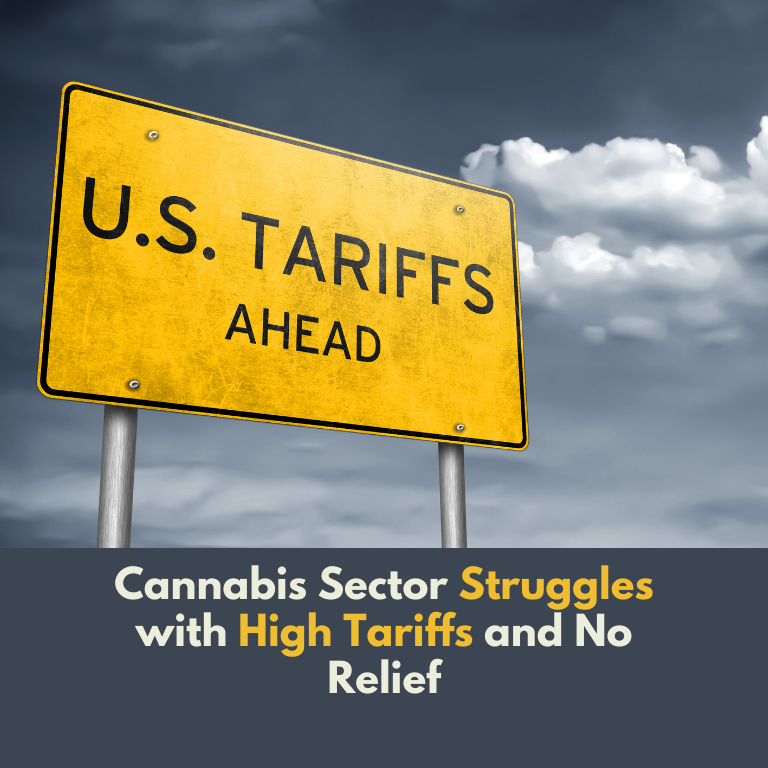Cannabis Industry Struggles as New Reciprocal Tariffs Shake Vape and Supply Chain Sourcing Amid Rising Costs
This week’s announcement of reciprocal tariffs by President Donald Trump is sending shockwaves through an already fragile cannabis supply chain, with businesses feeling the pressure of rising costs for essential components like vape hardware. As the cannabis industry braces for the economic fallout, many companies are scrambling to find ways to absorb the costs or pivot to new supply chains, but the road ahead remains uncertain.
New Reciprocal Tariffs on China and Other Countries Could Further Strain Cannabis Supply Chain as Costs Surge for Vape Manufacturers
On April 2, President Trump unveiled a 34% reciprocal tariff on Chinese imports, specifically targeting the supply chain of the cannabis industry. This new tariff increase, which raises the overall tariff rate on Chinese goods to 54%, will undoubtedly add to the already strained costs faced by cannabis businesses relying on Chinese raw materials like vape hardware. Furthermore, Trump’s plan to implement a baseline 10% tariff on all imports further compounds the financial strain.
The move comes as the cannabis industry has already been grappling with the impact of earlier tariffs imposed on Chinese and Canadian imports. On April 4, China retaliated with a 34% tariff on U.S. products, further escalating the trade war between the two countries and complicating the cost structure for American cannabis businesses.
Cannabis Companies Like Lume Cannabis Take Proactive Measures to Prepare for Tariffs While Others Struggle to Absorb Rising Costs
Kevin Kuethe, chief cultivation and production officer at Lume Cannabis in Michigan, spoke about the direct effects the tariffs are having on the vape segment of the cannabis market. “We’re starting to face a 2 or 3 cent increase per vape unit we sell to consumers,” Kuethe says. Given that the company processes hundreds of thousands of vape units each month, even a small increase can quickly add up to a significant cost hike.
However, Lume’s supply chain team had been preparing for such an eventuality since September, purchasing supplies before the tariff hikes were enacted. “We predicted that a new presidency would lead to some trade issues, so we bought as many units as possible before the tariffs came into effect,” he adds.
Unfortunately, not all companies have been as proactive. Jaunty, a vape, cart, and gummy producer based in Albany, New York, is seeing its hardware input costs skyrocket. CEO Nicolas Guarino revealed that his company now faces a 46% tariff rate on vape hardware from China, up from 36%. “We can figure out packaging, but with vape hardware, there really is no supply chain in the U.S. at scale for that kind of product,” he says.
While Guarino considers sourcing from countries outside of China, he acknowledges that the lack of a robust supply chain infrastructure in countries like Indonesia or Malaysia makes this option unfeasible in the short term. The tariffs imposed on Indonesia and Malaysia in early April only add to the complexity, with rates set at 32% and 24%, respectively.
Cannabis Businesses Brace for Future Price Increases as Tariffs on Key Inputs Continue to Climb
Both Kuethe and Guarino recognize the inevitable price hikes that will affect consumers if the tariff situation extends beyond the next few years. “At some point, that increase is going to filter down to the consumer,” Guarino states, adding that his company will have no choice but to pass along some of the cost increases if tariffs continue to rise.
As costs for inputs like vape hardware and cultivation materials continue to climb, cannabis businesses may have no choice but to adjust prices. However, companies in competitive markets like Michigan, where Lume Cannabis operates, face the challenge of navigating price sensitivity. Michigan’s cannabis market recently saw an all-time low for retail flower prices, with average costs dropping to $65.21 per ounce in February, according to the state’s Cannabis Regulatory Agency.
Greentank Technologies Offers Alternative as ‘Buy Canada’ Movement Gains Traction Amid Tariff Turmoil
In contrast to companies struggling with the impact of tariffs, Greentank Technologies, which supplies Jaunty with vape hardware, has seen a rise in Canadian clients, thanks to the “Buy Canada” movement. Peter Machalek, Greentank’s Chief Revenue Officer, notes that Canadian companies have sought out their products to avoid the tariffs on Chinese imports. However, Machalek warns that shifting production to the U.S. could lead to higher costs.
Machalek further emphasizes the challenges facing vape manufacturers, as many companies are currently locked into the existing supply chain from China. Transitioning to new suppliers, whether in Canada or other regions, would take time and may not result in the cost savings businesses are hoping for.
Cannabis Industry Leaders Call for Unified Response to Tariff Crisis as Supply Chain Challenges Mount
As cannabis businesses continue to adapt to the evolving tariff landscape, many are reconsidering their supply chain strategies. Kuethe also speculates that the impact of higher construction materials, which often come from Canada, could slow new cannabis facility builds, further affecting the growth of the industry.
Buy American Movement Stabilizes Costs for Some Cannabis Businesses as Tariffs Disrupt International Supply Chains
Some ancillary cannabis businesses, like Sana Packaging, have been able to stabilize their costs in the face of the trade war by focusing on domestic manufacturing. CEO Ron Basak-Smith reports that his company, which specializes in sustainable packaging made from ocean-based materials, has been able to lower costs by 15% thanks to its U.S.-based operations. This approach has allowed the company to offer competitive pricing without the volatility of international tariffs.
For now, the cannabis industry faces more challenges ahead as it navigates the turbulent waters of the trade war, and the economic ripple effects of these tariff increases may continue to reshape the supply chain for the foreseeable future.
OG source














